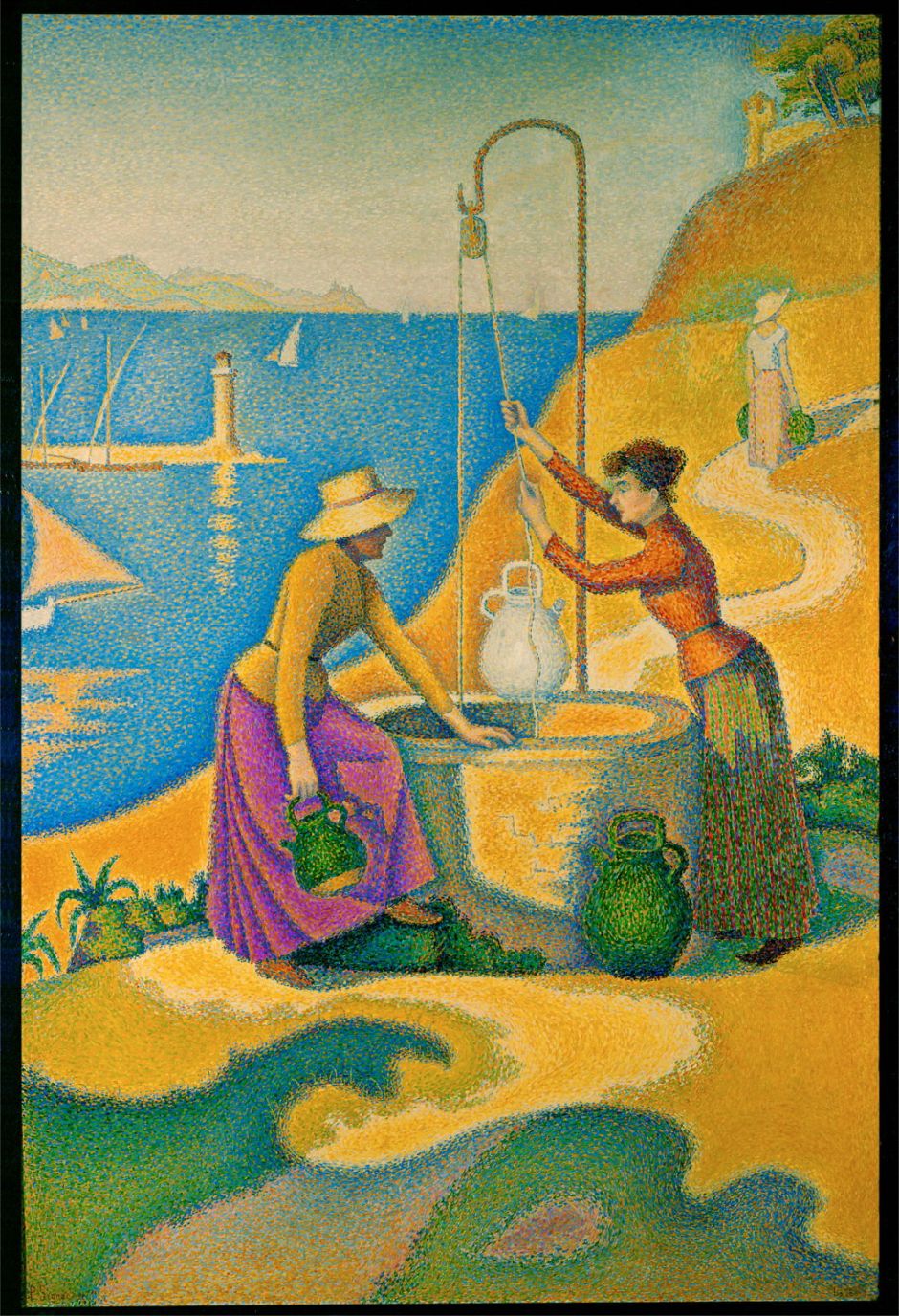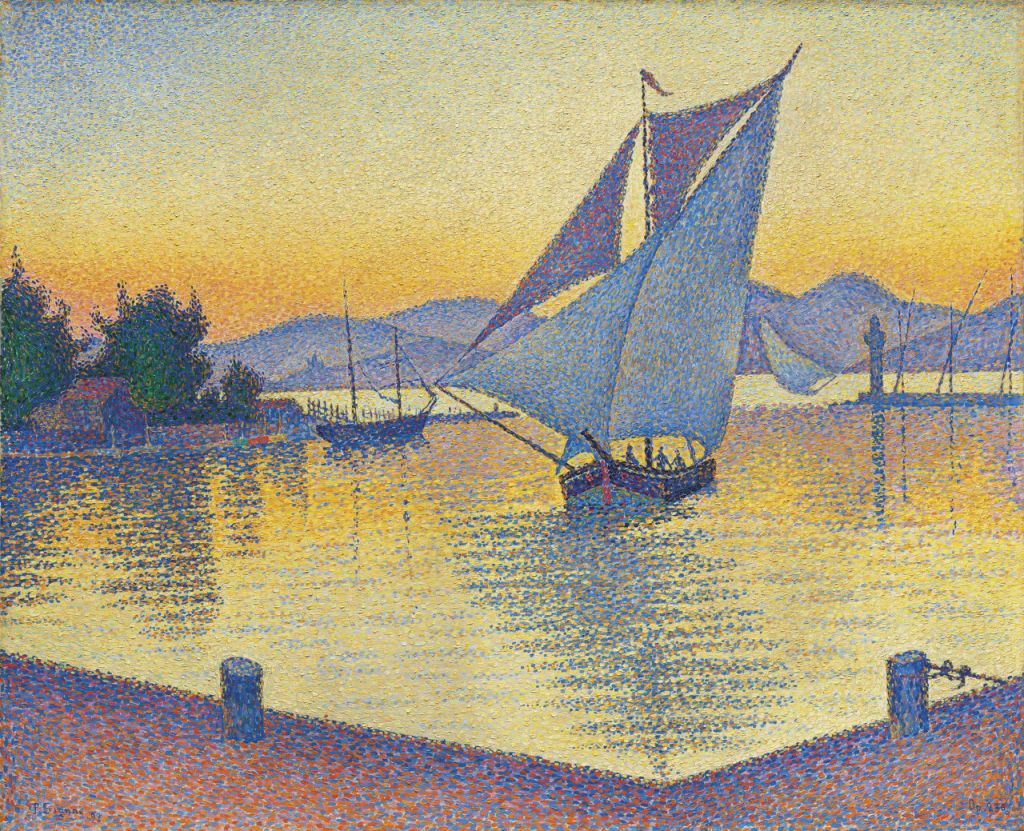In the autumn of 1889, Paul Signac (1863-1935) was busy completing a set of plates for two books by Charles Henry, a project which he estimated took him over six hundred hours. He was disappointed, though, by the rift between his Neo-Impressionists and Camille Pissarro, who had returned to Impressionism.
In January 1890, Signac again attended the Salon des XX in Brussels. This was marred by the painter Henry De Groux, who had made offensive remarks about Vincent van Gogh, which nearly ended in a duel. Over the winter, Signac was also busy finishing his masterpiece Sunday, which he exhibited at the Salon des Indépendents in March.

Sunday, which Signac started in October 1888 and completed in March 1890, is perhaps the best-known of his interiors, and continues their theme of the humdrum life of the bourgeoisie. It’s composition is a modification of Caillebotte’s Interior: Woman at the Window (1880), which Signac developed from a lithograph and a series of studies. Berthe Roblès modelled for the woman, but the man remains unidentified.
Its static, stultified composition and atmosphere are intentional, and pervade its every detail. Perhaps it’s those that have made this disappointingly unpopular from its first showing in the Spring of 1890.
Signac then travelled to Italy with his mother, returned to Paris briefly in April before going to stay in Saint-Briac and Saint-Cast in Brittany.

Port of Saint-Cast (1890 May) is a complete contrast. This was painted from the Plage du Châtelet looking towards the distant Fort La Latte on the left horizon, and the pointe du Châtelet at centre-right.
In May, Félix Fénéon published a biographical article on Signac, which was illustrated on the cover by the artist’s drawing of the author. Following that, Signac started work on a painted version, with which Fénéon described himself to be a willing accomplice. The first sitting for this was in November.
On 29 July 1890, Vincent van Gogh died in Auvers-sur-Oise.
In February 1891, Signac returned to the Salon des XX, and arrived back in Paris in time to prepare for the Salon des Indépendents, where he exhibited Fénéon’s portrait (below) and eight landscapes.

Against the Enamel of a Background Rhythmic with Beats and Angles, Tones, and Tints, Portrait of M. Félix Fénéon in 1890 (1890-91) is a unique combination of colour theory, Japonisme, decorative art, and portrait. Its background consists of colour wheels expressed according to a Japanese kimono pattern.
Fénéon is shown as the dandy he appeared to be, but has the air of a circus ringmaster, perhaps reflecting his ability to spot and encourage artistic talent. He was an odd contradiction, by day a clerk in the War Ministry, a well-known anarchist suspected of bombing a restaurant in 1894, and one of the most astute art critics of the time. Somehow Signac captures all of those, together with their long friendship. Signac gave Fénéon this portrait, and Fénéon cherished it for the rest of his life.
Less than a week after Signac and Seurat had attended Gauguin’s departing dinner, Georges Seurat died suddenly on 29 March 1891, at the age of just 31. Signac attended his funeral two days later. Camille Pissarro declared that, with the movement’s leader dead, “pointillism” was finished.
In May, while he was also busy compiling an inventory of Seurat’s works to enable his estate to be settled, Signac visited the port of Roscoff in Brittany, where his new yacht Olympia, a 12 metre cutter, was being built. He returned when it had been completed that summer, then sailed competitively with Fénéon in August and September, particularly at Concarneau.

Evening Calm, Concarneau, Opus 220 (Allegro Maestoso) (1891) above and Concarneau, Return of the Sloops (presto finale) (1891) below are two of his series of maritime paintings from that summer. They received favourable reviews, and, unusually for Signac, sold quite quickly too.

These mark the end of Signac’s first period of Divisionism, before he discovered the Midi.
At the start of 1892, Signac travelled to Brussels, where Les XX held an exhibition in honour of Georges Seurat. He then returned to Paris for the Spring Salon des Indépendents, where he exhibited seven works, including views of Concarneau.
On 24 March Signac, Berthe Roblès his partner, and another sailor left Brittany on board the yacht Olympia. They sailed first to Bordeaux, where Théo Van Rysselberghe joined them, then inland on the River Garonne to Toulouse, where they followed the Canal du Midi to reach the Mediterranean on 14 April.
Signac then spent early May in Saint-Tropez, where he rented a cottage in the old town, and announced his intended marriage to Berthe Roblès.

Soleil couchant sur la ville (étude) is an oil study Signac painted on wood in 1892, which appears Fauvist in the intensity of its colours. It shows a view of Saint-Tropez which he turned into a finished Divisionist painting, as well as producing another sketch in Conté crayon, and an unusual drawing in watercolour and ink which is reminiscent of Van Gogh, and prescient of his later watercolours.

During his short stay in Saint-Tropez, Signac painted its harbour from several different angles. Le Port au soleil couchant, Opus 236 (Saint-Tropez) (1892) is one of the most successful of these, with its echoes of Concarneau.

Women by the Well (1892) is an unusual work, perhaps the product of Signac’s new role as the leader of Neo-Impressionism. A combination of landscape with figures, it was influenced by Puvis de Chavannes, and set in a synthetic location near Saint-Tropez. Parallels have been drawn with Seurat’s The Circus, which he had left unfinished, although these aren’t easy to see. A few critics wrote in its praise, but most of his peers considered it an unfortunate mistake.
Four days before his thirtieth birthday, on 7 November 1892, Signac married Berthe Roblès in Paris. Among the four witnesses were Maximilien Luce and Camille Pissarro.
References
Cachin F (2000) Signac. Catalogue raisoné de l’Oeuvre Peint, Gallimard. ISBN 2 07 011597 6.
Ferretti-Bocquillon M et al (2001) Signac 1863-1935, Yale UP. ISBN 0 300 08860 4.
Ferretti-Bocquillon M et al. (2013) Signac, les Couleurs de l’Eau, Gallimard. ISBN 978 2 07 014106 7.

